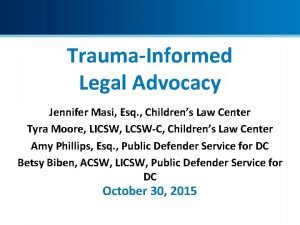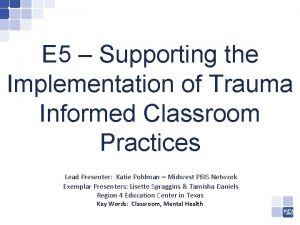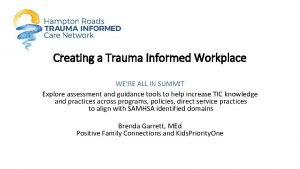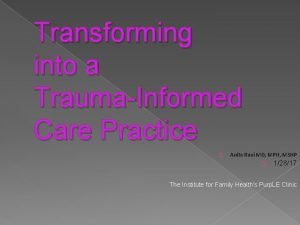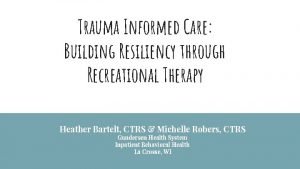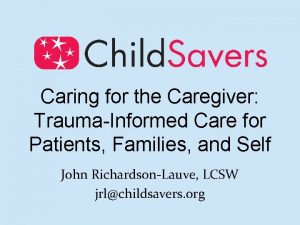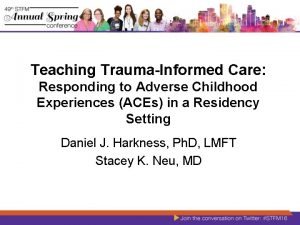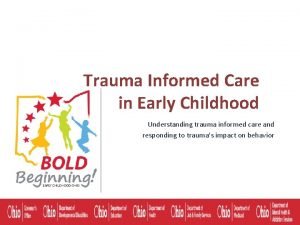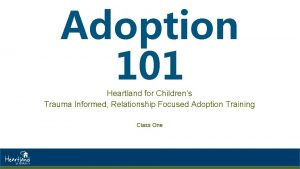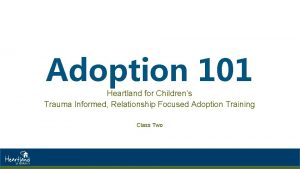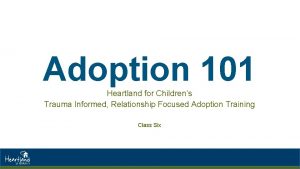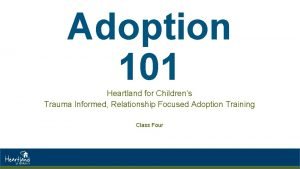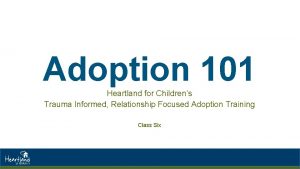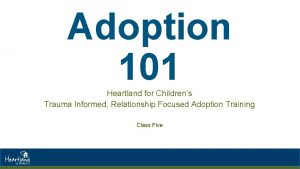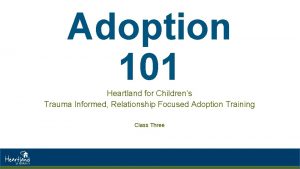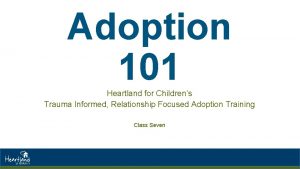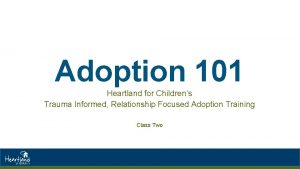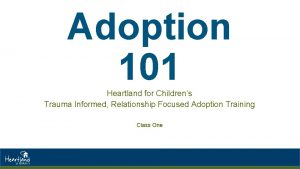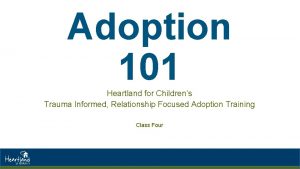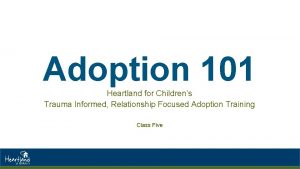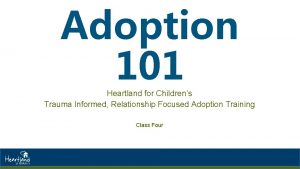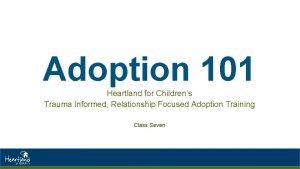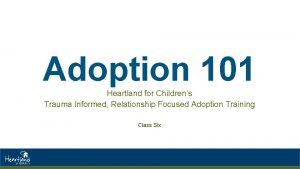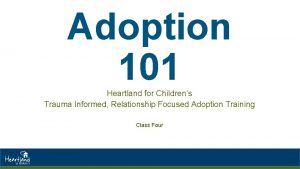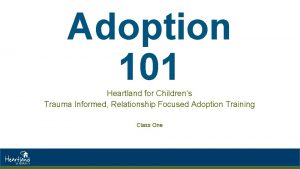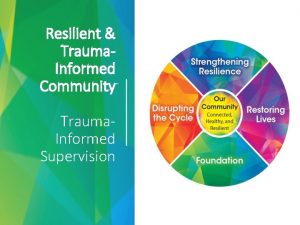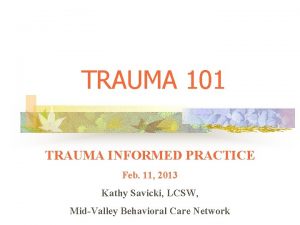Adoption 101 Heartland for Childrens Trauma Informed Relationship
























- Slides: 24

Adoption 101 Heartland for Children’s Trauma Informed, Relationship Focused Adoption Training Class Seven

Welcome To Adoption 101, Class Six! • Welcome back! • Discussion of last week & homework • Today’s Agenda! • Guest Speaker • Correcting Principles & Tips & Tools

Correcting Principles The Balance between Structure & Nurture

Correcting Principles • What is important to remember is that the underlying goal of correction should always be to improve the connection between the parent and the child through ways we help a child feel safe as we guide them. However, the explicit goal of correcting principles is to teach, mentor, coach, and correct. • When the goal is connection, everyone is on the same team. When the goal is punishment, the caregivers and children become adversaries. • We must remember that kids are doing the best they can in the moment with the tools they have available to them.

Setting the Bar • We must set the bar to a place where we know the child can achieve, and then slowly raise the bar over time. • What things do you think we need to consider when setting the bar?

Goals of Correction • Of course, we want to change behavior. However, our goal should also be to maintain connection and felt safety. We also want to both the adult and the child to feel content. • Remember, our kids do not always feel safe even if they are physically safe. To feel safe, a child feels…. • CONNECTED • LIKE THEY BELONG • THAT THEY CAN BE THEMSELVES • *SEEN*HEARD*VALUED*

“Catch it Low” • As you get to know your child, ensure you are observant of the things that calm and stress your child. Look for small warning signals indicating that they are beginning to stress. • Remember they are “simmering” and their “boiling” point does not take long. • “Catch it” before it escalates! Use play to redirect and/or calming strategies that you know will help to calm your child. • Share Power and give your child voice to express themselves (or help them to express themselves)

More "Catch it Low” Proactive Strategies • Use play as a way to teach. Role play to teach life value terms/skills. Allowing the child to play out scripts of what not to do and what to do. • The whole family should participate • Life value terms could include: respect, use your words, gentle & kind, accepting consequences & no, asking permission, etc. • Incorporate practice of choices, compromises, and re-do’s

All of this requires Sharing Power • How might your history and experiences make it difficult for you to share power?

Building your toolbox! • There is no one “tool” or magical way to parent, never mind parent a child who has been through trauma! • #1: SELF CARE! Easy on good days, harder to do on challenging days. • Interact with the children based on their emotional age, not physical age • Listening to behavior instead of reacting to a child’s behavior allows us to understand their needs. Respond, do not react. • Making sure you are calm (tone of voice and body language) when responding. You are teaching your child how to be calm in chaos. • • Children will learn more through what we do than what we say. Model gentle, empathic, understanding, quiet, and calm responses to them. • Slow & Low and do not break the relationship

Toolbox, continued: • Positive attention that is prompt, predictable, and consistent. • • Be specific: “I really appreciated how you shared your toy with your sister” Be warm and genuine (they can pick up on any indications of you not meaning it) Be prompt Keep it all positive! Praise the positive opposite: Not “thank you for not lying”, but “thank you for telling the truth” • Special Time: 1 on 1 time that is just for them, even if just 15 minutes a few times a week • Praise • Kids with trauma history should get an average of 6 praises for every 1 consequence. • Initially a child may not know how to take praise as it doesn’t align with their “self image” or what they are used to. Don’t take personally if they are initially resistant. • Positive Attention and Praise is not spoiling a child. It will increase behavior you want to see, increase their motivation and self esteem, and it models respect and focusing on positivity.

Toolbox, continued: • Consequences There is a time and a place for consequences. Always keeping in mind appropriateness of the consequence. Avoid power struggles. Be clear, calm, and consistent (follow through!) Not every behavior needs a consequence, but can be discussed, and future consequences can be discussed if done again. Think about circumstances and keep in mind how it is about teaching! • There are natural consequences that you can also discuss with the child and won’t necessarily need additional consequences. • Never break the relationship! • • •

REGULATE, RELATE, THEN REASON

More Tips & Tools • Interactive Repair: teaches that a child is still accepted and loved, even if they have done something wrong. Ignore the behavior, love the child. • Parent should be the source of comfort in relaying the message that they still love the child (unconditional commitment!) • Reframing: thinking about the child and their actions/behaviors from the child’s point of view. • “Wow, you’re really mad!” • “It’s okay to cry, but let’s talk about what’s the matter” • When triggered, a child will often react as if the terrifying experience is happening again and has a hard time explaining his/her reaction. Thus, a child needs to know that the parent understands, and will do everything to keep them safe.

More Tips & Tools… • Claiming Behaviors is the process of assimilating a child into the family and helping the child to feel apart of the family. Very symbolic in that they communicate acceptance and integration. • Provide structure and flexibility. Our children need both consistency and structure to feel safe. It is important to have routines, but also flexibility as needed. Structure = Safety! • Using Time In, not Time Out. Time out teaches a child to go away when things are bad. Time In communicates to them that you are here for them despite their behavior. This time should be used to help them regulate and then when they are calm it is a good teaching moment. Discipline should be about teaching. • Be aware of overstimulation. Remember the five senses and try not to overstimulate the child. • All goes back to safety & love. • “I will not let others hurt you, or you to hurt others”. • “I love you and when you lie to me it hurts my feelings that you don’t trust me”.

Responsive Strategies • While the hope is to “catch it low” and redirect through play; we know this will not always occur. Thus, here are some tools for responding in times of an escalation of emotional/behavioral needs. • We will look at Levels of Response and the IDEAL Approach, which are recommended through Trust. Based Relational Intervention®.

Levels of Response • Level One: Playful Engagement • Respond to a challenging behavior playfully, redirecting and maintaining connection. • Level Two: Structured Engagement • If level 1 doesn’t work, you may need to be more structured. Often this is by providing choices to the child. • Level Three: Calming Engagement • If challenging behavior persists and escalates, focus on de-escalation through calming is vital. This could be recommending a break/quiet time, time-in, deep breathing, etc. • Level Four: Protective Engagement • If the child is unable to de-escalate, their challenging behavior escalates to a level of self-harm or harm to others, the focus is on maintaining safety for everyone. Stay calm ALWAYS RETURN BACK TO LEVEL ONE, PLAYFUL ENGAGEMENT

IDEAL Response • IDEAL is an acronym to remind caregivers of the five principles used to respond to youth. • I: Respond IMMEDIATELY • D: Respond DIRECTLY through eye contact, undivided attention, and maintaining close proximity. • E: Respond EFFICIENTLY using the least amount of firmness, corrective effort, and verbal directive required to correct the behavior. • A: ACTION-BASED response, giving them the opportunity for a re-do. • L: LEVEL the response at the behavior, not at the child. Never reject the child, respond to the behavior.


Understanding Behavior from Trauma Lens • Traditional parenting techniques do not help a child learn to regulate through the parentchild relationship. • Traditional parenting assumes that our children can take in, process and learn from complex information and complex relationships and to then make logical and rational decisions about what to do with the information. • A hi-jacked/Flipped Lid brain does not reason, it reacts! • Yet, many children in care have delayed brain development and are in a fight, flight, or freeze mode which inhibits their ability to make rational and logical decisions. • When you “fight back” with a child who is “fighting” – you are proving to that child that he/she needs to fight. Thus, it is important that you are regulated and not reactive to their “fighting” behaviors.

Your viewpoint of the child • What you learn in these classes regarding trauma and how behaviors you see are really a external display of a child’s internal fears is a key starting point in being a therapeutic parent. If you do not believe what we are teaching, it will be difficult for you to embrace the ideas for parenting tips and tools we will discuss today. • You are basically going to be tasked with being an “investigator”. You are going to look for trends and clues in behaviors that can identify possible triggers and attempt to find out the why of why the behavior is occurring. • You can be the central ingredient in the child’s recovery if you are willing to accept the challenge of parenting these special needs children. You hold the KEY to unlocking that child’s future!

Successful Therapeutic Parenting Begins with You! • The best way to impact your child is through experiences and parental presence. Yet, first the parent must first make sense of their own life! • Support System! “Study after study shows that having a good support network constitutes the single most powerful protection against becoming traumatized”. The Body Keeps the Score, Bessel Van Der Kolk Yet, you can be the best parent and still have a child with challenges.

Questions? • Homework: • Support System • “On Love” article & questions • Where do you Land? • Characteristics Preferences Checklist (*Only for unmatched families) • Handouts: • The IDEAL Response© • Levels of Response™ • Trust-Based Relational Intervention®: Life Value Terms • Trust-Based Relational Intervention (TBRI): A Systemic Approach to Complex Developmental Trauma • Step Up for Students Flyer • Next Week: Sexual Safety, benefits of Adoption, and discussion of the adoption process

Thank you!!! • Certificates: You will receive your certificate by email once all homework has been submitted. • Class Report Cards: You will received an email with a 5 minute Survey Monkey link as to the class. Please complete ASAP. Your input is helpful. (Note: Please note if you are assigned to a CMO, the home study will be discussed by your CMO)
 Trauma informed legal advocacy
Trauma informed legal advocacy Lgbt trauma informed care
Lgbt trauma informed care Trauma informed advising
Trauma informed advising Trauma informed physical environment
Trauma informed physical environment Trauma-informed workplace assessment
Trauma-informed workplace assessment Trauma informed peer support
Trauma informed peer support Dr anita ravi
Dr anita ravi Trauma informed parenting discipline
Trauma informed parenting discipline Trauma informed practice
Trauma informed practice Trauma-informed questions for clients
Trauma-informed questions for clients Www.dfps.state.tx.us/training/trauma informed care/
Www.dfps.state.tx.us/training/trauma informed care/ Pillars of trauma informed care
Pillars of trauma informed care Trauma informed practice
Trauma informed practice Trauma informed practice
Trauma informed practice 4 r's trauma informed care
4 r's trauma informed care 4 r's trauma informed care
4 r's trauma informed care Sensory modulation
Sensory modulation Trauma informed icebreakers
Trauma informed icebreakers Trauma informed care for foster youth
Trauma informed care for foster youth Goodwill of the heartland
Goodwill of the heartland Tradin post
Tradin post Backwash effect ap human geography definition
Backwash effect ap human geography definition Heartland health and wellness
Heartland health and wellness Ratzel theory
Ratzel theory Rimland caribbean
Rimland caribbean
